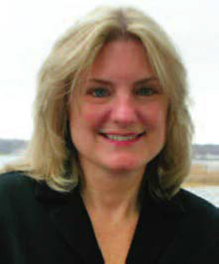The Takeaway: Learn how one New Jersey community incorporated stricter building standards in its floodplain ordinance as residents recovered from a major storm.
Overview
In 2012, Post-Tropical Cyclone Sandy swept record-setting floods into New Jersey’s Monmouth Beach, a tiny borough on the Jersey Shore near Sandy Hook. As the community began its recovery, the mayor joined forces with two commissioners to update Monmouth Beach’s floodplain ordinance so it exceeded both current state construction standards and the elevation above predicted flood levels. The goal was to ensure that community buildings would be less likely to flood well into the future. These new standards were implemented during a challenging time, when disaster recovery and new changes to flood insurance requirements were affecting rebuilding decisions. Extensive public outreach greatly contributed to community acceptance of the new requirements.

Lessons Learned
- Understand that policy changes are hard to accomplish when recovering from a disaster. Developing a formal policy during storm recovery is challenging because of the many conflicting issues and responses from various levels of government.
- Continually engage builders and contractors. Educating builders and contractors is an ongoing, near-daily process.
- Give people the information they need. Residents want to do the right thing, but they need to be educated and get answers to questions.
- Help people solve problems and find resources for storm recovery. Sustained public engagement should offer solutions, including help with applying for grants.
- Sue Howard, mayor of Monmouth Beach, New Jersey</p>
The Process
Monmouth Beach, a small New Jersey borough on the Jersey Shore, suffered record-setting floods during 2012’s Post-Tropical Cyclone Sandy. Some houses that had survived unscathed in all other storms during the past 100 years suffered some level of Sandy-related flood damage. Less than two months after the storm, the Federal Emergency Management Agency released Advisory Base Flood Elevation maps to help property owners and communities make decisions about rebuilding. These maps conservatively estimated base flood elevations expected to be in the new Flood Insurance Rate Maps (which were not released until more than six months after the storm). During this turbulent time, community officials and residents worked through challenging decisions with the potential to affect flood resilience over the next century.
Advisory Base Flood Maps
The Advisory Base Flood Elevation maps released in December 2012 did not incorporate an overland wave analysis, which determines where the highest-risk velocity zones and Coastal A zones are located. As a result, many areas were mapped into these highest-risk areas based on a conservative wave analysis estimate. That meant flooding at the one-percent level, or the so-called 100-year flood, could produce either a three-foot or one-and-a-half foot wave.
Residents along the New Jersey coast feared that the additional height included could drastically affect flood insurance rates as well as rebuilding requirements. However, Mayor Sue Howard and commissioners Jim Cunniff and Bill McBride believed that using these strict standards was critical to the community’s recovery effort, ensuring that houses would be as flood-resistant as possible. Monmouth Beach adopted these maps as the community’s flood map standard.
New Freeboard Requirements
Monmouth Beach also adopted stringent new freeboard standards requiring all structures in floodplains to have three feet of freeboard—two feet higher than the state minimum standard. Houses that were substantially damaged—the cost of damage equal to or exceeding 50 percent of the pre-storm value of the structure—had to be rebuilt to meet the new requirement. This meant that some houses would have to be elevated by nearly one story. The borough has allowed a variance for those houses being elevated to meet the height limit as long as the total height of the structure remains at or below 38 feet.
Velocity Zone Standards
In addition to the freeboard elevation, Monmouth Beach required that houses located in Coastal A zones—which could experience waves of one-and-a-half feet on top of floodwaters—be built to velocity zone standards. Howard and other borough officials were concerned about whether the municipality could enforce the stronger construction standard because, at the time, it exceeded the New Jersey state building code requirements. Until March 2016, when the state adopted the standard into the building code, the borough granted variances to property owners if requested. However, the borough used the variance hearing as another opportunity to discuss with property owners the importance of preparing for current and future flood risks by building to the stronger standard.
Flood Policy Challenges
The borough’s changes to floodplain ordinances came in the midst of major flood policy turmoil. The state announced it would enforce a longstanding rule to bring all substantially damaged properties up to current flood elevations, plus at least one foot of freeboard. At the federal level, looming changes to the National Flood Insurance Program through the Biggert-Waters Act would eliminate flood insurance subsidies and bring rates up to the actuarial level. While many communities in New Jersey banded together to protest the changes, there was little controversy in Monmouth Beach.
Public Engagement
The borough’s many public engagement efforts kept controversy from erupting over the new floodplain-building requirements. The community connected residents to resources for rebuilding and elevating their properties. Residents began to better recognize the risks of living near the water. The borough sent out weekly emails with rebuilding and recovery information as well as information about flood preparedness and resilience. Community meeting presentations also were sent to residents via email. Borough officials displayed hard-copy emails and presentations in the borough hall and asked residents to share information with neighbors who might not use computers. The messages from Howard and community staff members contained simple and concise language and bullet points. The community also used a reverse 911 system to send out phone calls alerting residents of public meetings.
Outcome
Monmouth Beach’s ordinance now requires the base flood elevation as specified in either the Advisory Base Flood Elevation maps or the current Federal Insurance Rate Maps plus three feet, noting that property owners must use whichever standard is most restrictive. The borough is one of the few New Jersey coastal municipalities with freeboard requirements of at least three feet above base flood elevation. Houses continue to be elevated, with many of these homeowners using the Community Development Block Grant disaster recovery grants. New construction, or houses that have been torn down and rebuilt from the ground up, are being built to these new standards. Some homeowners are opting to go even higher so they can incorporate parking beneath their houses, providing the added benefit of increasing on-street parking in some neighborhoods.
Next Steps
Monmouth Beach continues to educate builders and homeowners about the requirements and why they are in place. The borough is preparing to apply for inclusion in the Community Rating System. However, more than 100 houses in this community were potentially built in ways that violate National Flood Insurance Program requirements. Monmouth Beach is still assessing these properties and will begin substantial public engagement with the homeowners.
